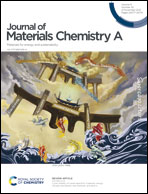Pseudocapacitive sodium storage in a new brand foveolate TiO2@MoSe2 nanocomposite for high-performance Na-ion hybrid capacitors†
Abstract
Preparation of a material with excellent rate performance and high capacity contribution is significant for sodium-ion hybrid capacitors (SIHCs). TiO2 has been extensively studied due to its outstanding chemical stability, but the low specific capacity greatly hinders its practical application. Herein, TiO2 with a foveolate-shape is prepared via a precisely controlled Ostwald maturation procedure. Benefiting from the unique structure, foveolate TiO2 possesses satisfactory electrochemical performance. When used as the anode for SIHCs, a high reversible specific capacity of 290 mA h g−1 is obtained with an ultrahigh initial coulombic efficiency of 96% at 100 mA g−1. Even if the current density increases to 1000 mA g−1, the specific discharge capacity can still be maintained at 158 mA h g−1 after 1500 cycles. To further improve its capacity, the TiO2@MoSe2 composite electrode is synthesized by using foveolate TiO2 as the skeleton for the successful growth of MoSe2 nanosheets. A higher reversible specific capacity of 551 mA h g−1 is achieved at 100 mA g−1. Moreover, a reversible specific capacity of 164 mA h g−1 is maintained after 500 cycles at 5000 mA g−1. The foveolate TiO2 preparation method developed in this work provides new ideas for the development of both substrate materials and active materials in the field of energy storage.



 Please wait while we load your content...
Please wait while we load your content...